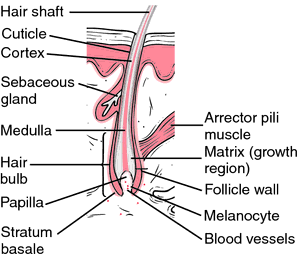hair
[hār]1. any thin, threadlike structure.
2. especially, the specialized epidermal structure produced only by mammals, developing from a papilla sunk in the corium. The life cycle of a hair (hair cycle) consists of three phases, called anagen, catagen, and telogen. Called also pilus.

Structure of hair and hair follicles. From Applegate, 2000.
3. the aggregate of such structures.
bamboo hair trichorrhexis nodosa.
beaded hair hair marked with alternate swellings and constrictions; seen in monilethrix.
burrowing hair one that grows horizontally in the skin, causing a papule that may become infected; see also pili cuniculati, under pilus.
club hair a hair whose root is surrounded by a bulbous enlargement composed of keratinized cells, preliminary to normal loss of the hair from the follicle.
Frey's h's stiff hairs mounted in a handle; used for testing the sensitiveness of pressure points of the skin.
ingrown hair one that has curved and reentered the skin, causing a papule that may become infected. See also pili incarnati, under pilus.
lanugo hair the fine hair on the body of the fetus.
moniliform hair beaded hair.
pubic hair the hair on the external genitalia; called also pubes.
sensory h's hairlike projections on the surface of sensory epithelial cells.
tactile h's hairs sensitive to touch.
taste h's short hairlike processes projecting freely into the lumen of the pit of a taste bud from the peripheral ends of the taste cells.
terminal hair the coarse hair on various areas of the body during adult years.
twisted hair a hair that is twisted through an axis of 180 degrees at spaced intervals, being abnormally flattened at the site of twisting. See also pili torti, under pilus.
Miller-Keane Encyclopedia and Dictionary of Medicine, Nursing, and Allied Health, Seventh Edition. © 2003 by Saunders, an imprint of Elsevier, Inc. All rights reserved.
club hair
a hair in resting state, before shedding, in which the bulb has become a club-shaped mass.
Farlex Partner Medical Dictionary © Farlex 2012
club hair
(klŭb hār)A hair in resting state, before shedding, in which the bulb has become a club-shaped mass.
Medical Dictionary for the Health Professions and Nursing © Farlex 2012